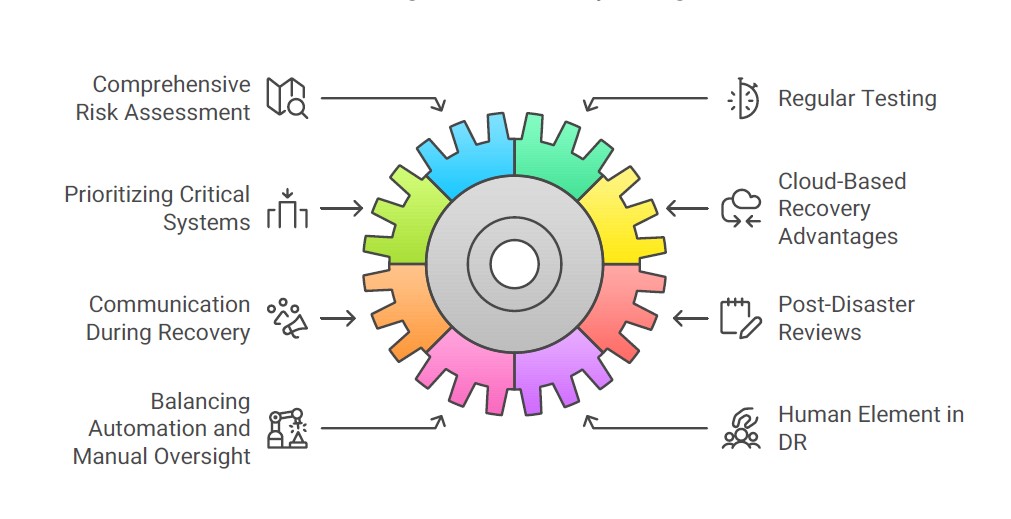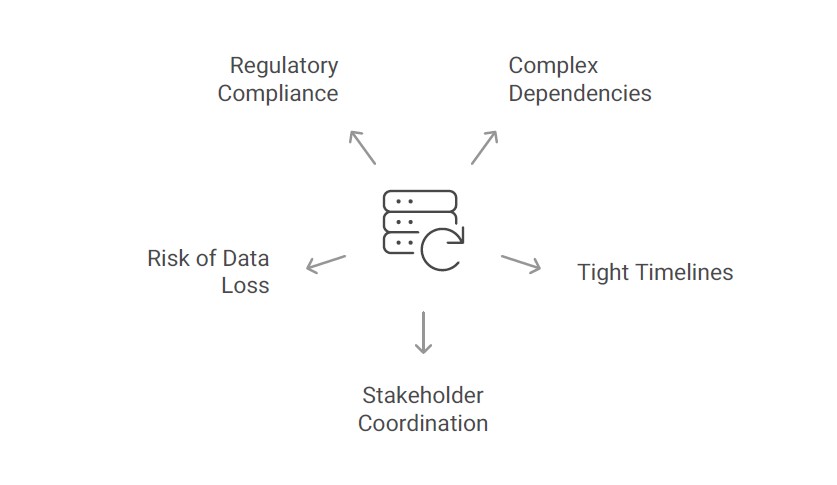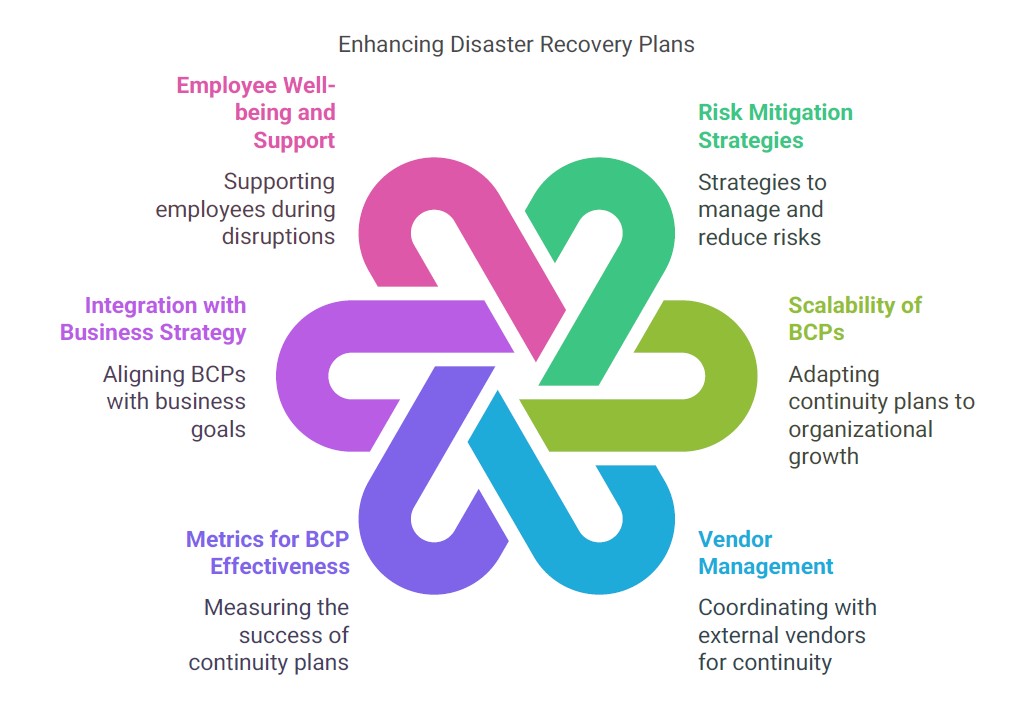Key Challenges in Data Center Migrations and Disaster Recovery
Before diving into actionable strategies, it’s important to understand the common challenges faced during data center migrations and disaster recovery efforts:
- Complex Dependencies: Modern IT environments involve interconnected applications, databases, and infrastructure components. Any disruption to one element can have a cascading impact on others.
- Tight Timelines: Both migrations and recoveries often operate under strict deadlines, leaving little room for error or delay.
- Stakeholder Coordination: Collaboration across multiple teams, including IT, operations, and external vendors, is crucial but can be challenging to manage.
- Risk of Data Loss: Ensuring data integrity during migrations and recoveries is paramount. Even minor data corruption can have far-reaching consequences.
- Regulatory Compliance: Organizations must adhere to regulatory requirements for data security and disaster preparedness, adding another layer of complexity.
Understanding these challenges sets the stage for building a resilient BCP that can address
and overcome them effectively.
Actionable Insights for Building Robust BCPs
- Conduct a Comprehensive Risk Assessment
A strong BCP begins with identifying potential risks and vulnerabilities. For example, during a data center migration, assess risks such as hardware failures, configuration errors, and network outages. Similarly, in DR planning, consider natural disasters, cyberattacks, and system malfunctions.
Use tools like risk matrices and impact analysis to prioritize threats based on their likelihood and potential impact. By understanding the risks, organizations can allocate resources more effectively and develop targeted mitigation strategies. - Develop a Detailed Inventory of Assets
Understanding what’s at stake is critical. Create a comprehensive inventory of all assets, including servers, applications, databases, and network components. During data center migrations, this inventory helps map dependencies and ensures nothing is overlooked. In disaster recovery, knowing the critical systems and their interdependencies enables quicker prioritization during restoration. - Establish Clear Roles and Responsibilities
BCP execution requires coordination among various teams. Define roles and responsibilities for each stakeholder involved in the plan. For instance, assign specific teams to handle data backups, infrastructure setup, and communication during a migration. Similarly, in DR scenarios, designate roles for system recovery, incident management, and client communication. - Emphasize Redundancy and Resilience
Redundancy is a cornerstone of business continuity. During data center migrations, maintain redundant systems to ensure operations continue uninterrupted. Use active-active configurations or failover mechanisms to minimize downtime. In DR planning, ensure off-site backups and redundant power supplies to safeguard against data loss and operational disruptions. - Leverage Automation and Real-Time Monitoring
Automation tools can significantly enhance the efficiency and reliability of both data center migrations and DR operations. For example:
- Use automated scripts to streamline data transfers during migrations.
- Employ real-time monitoring tools to detect anomalies and prevent issues before they
escalate.
Automation reduces human error, accelerates processes, and provides valuable insights for decision-making.
- Prioritize Testing and Simulations
Testing is where theory meets practice. Regularly simulate disaster scenarios and migration processes to identify gaps in the plan. For instance, conduct mock data center migrations to ensure smooth execution during the actual event. Similarly, run disaster recovery drills to test system restoration and team readiness.
Post-test reviews are essential for identifying weaknesses and refining the plan. - Foster Cross-Functional Collaboration
Collaboration is the backbone of effective BCP implementation. Encourage cross-functional meetings to align goals, share insights, and build trust among teams. During data center migrations, involve application owners, infrastructure teams, and external vendors to ensure comprehensive planning. In DR scenarios, collaboration between IT, legal, and public relations teams is crucial for managing the aftermath effectively. - Maintain Transparent Communication
Communication can make or break a BCP. Establish clear communication protocols for all stakeholders, including internal teams, clients, and vendors. Use multiple channels, such as email, messaging apps, and dashboards, to ensure timely updates. During data center migrations, provide progress reports to keep everyone informed. In DR scenarios, transparency builds trust and mitigates panic among stakeholders. - Embrace Continuous Improvement
BCPs are not static documents. Treat them as living frameworks that evolve with changing business needs and technological advancements. Conduct post-event reviews to capture lessons learned and incorporate them into future plans. For example, after a data center migration, analyze what worked well and where improvements are needed. Similarly, after a disaster recovery effort, document challenges faced and refine strategies accordingly.
Real-World Examples of Effective BCP Implementation
Case Study 1: Data Center Migration Success
A global financial services firm faced the daunting task of migrating its primary data center while ensuring uninterrupted operations. By following best practices in BCP:
- Risk Assessment: Identified potential bottlenecks and implemented failover systems.
- Role Clarity: Assigned dedicated teams for data transfer, infrastructure setup, and stakeholder communication.
- Testing: Conducted multiple mock migrations to validate processes.
The result? A seamless migration was completed ahead of schedule with zero downtime.
Case Study 2: Disaster Recovery Resilience
A mid-sized e-commerce company experienced a ransomware attack that crippled its operations. Thanks to a robust BCP:
- Preparedness: Regularly tested backups and ensured off-site storage.
- Collaboration: IT and legal teams worked together to mitigate impact and handle public relations.
- Transparency: Communicated openly with customers about the steps being taken to resolve the issue.
Within 48 hours, the company restored its systems and resumed operations with minimal reputational damage.
Building resilient Business Continuity Plans requires a blend of strategic foresight, meticulous planning, and continuous improvement. By drawing lessons from data center migrations and disaster recovery experiences, organizations can develop BCPs that not only mitigate risks but also empower teams to navigate disruptions with confidence. From conducting comprehensive risk assessments to fostering collaboration and leveraging automation, each step contributes to a robust continuity framework. As businesses continue to face an increasingly complex and uncertain landscape, investing in resilient BCPs is not just prudent—it’s essential for long-term success.
Leveraging Cloud Technologies for Business Continuity
The rise of cloud computing has transformed how organizations approach disaster recovery (DR) and business continuity planning (BCP). Traditional on- premises solutions often struggle to match the flexibility and scalability of cloud platforms. With cloud services, businesses can create highly redundant systems that ensure availability and resilience. A key strategy is adopting a hybrid or multi-cloud approach. This involves distributing workloads across multiple cloud providers or maintaining a mix of on-premises and cloud-based environments. Such diversification minimizes risks tied to a single point of failure. For example, a multi-cloud approach can ensure real-time replication of critical data, allowing businesses to shift operations seamlessly in the event of a disaster. Automation plays a critical role here. Cloud platforms often provide built-in tools for failovers, replication, and workload orchestration. Features like AWS Auto Scaling or Azure Site Recovery allow businesses to automate recovery processes, significantly reducing recovery time objectives (RTOs) and recovery point objectives (RPOs). These technologies also support regular testing of disaster recovery scenarios, enabling organizations to refine their plans without disrupting day-to-day operations.
The Role of AI and Machine Learning in Disaster Recovery
Incorporating artificial intelligence (AI) and machine learning (ML) into business continuity strategies can revolutionize how organizations detect, respond to, and recover from disruptions.
AI tools analyze historical and real-time data to predict potential failures or disruptions. For instance, an AI system monitoring a data center might detect patterns indicating a hardware failure or overheating, allowing proactive maintenance before issues escalate. Such predictive analytics significantly reduce downtime by addressing problems at their source. ML algorithms can also enhance incident response automation. Imagine a scenario where a network utage occurs. AI-driven solutions can instantly reroute traffic, allocate resources, and notify relevant teams, all without manual intervention. This agility is critical for maintaining service availability during crises.
Additionally, AI systems can simulate disaster scenarios to test the resilience of a BCP. These simulations provide insights into vulnerabilities, enabling businesses to fine-tune their strategies for better outcomes.
Case Studies: Success Stories in Resilient BCPs
Case Study 1: Financial Sector - Flood Recovery with Cloud Redundancy
A major financial institution faced a severe flood that incapacitated its primary data center. Thanks to a robust BCP, including a cloud-based disaster recovery plan, the organization swiftly switched to a backup system hosted in a different region. The automated failover mechanism ensured zero data loss and minimal downtime, preserving client trust and operational integrity.
Case Study 2: E-commerce Sector - Seamless Data Center Migration
An e-commerce company planned a data center migration while ensuring 24/7 operations. By implementing a phased migration strategy and maintaining dual-running systems, they avoided downtime. A pre-tested recovery plan, coupled with comprehensive communication to stakeholders, ensured a seamless transition and continued customer satisfaction.
Building Cybersecurity Resilience into BCPs
In today’s digital landscape, cyber threats like ransomware and data breaches are as disruptive as natural disasters. Integrating robust cybersecurity practices into your BCP is no longer optional.
A key tactic is maintaining immutable backups—snapshots of data that cannot be modified or deleted. These backups protect organizations against ransomware attacks, allowing data to be restored quickly without paying ransoms.
Incident response planning is another critical element. This involves predefining steps to takewhen a cybersecurity breach occurs, such as isolating affected ystems, notifying stakeholders, and involving cybersecurity teams. Regular penetration testing and security audits can identify vulnerabilities before attackers do, ensuring preparedness for potential threats.
Compliance and Legal Considerations in BCP
Effective business continuity plans must adhere to industry regulations and standards. Frameworks like ISO 22301 provide comprehensive guidelines for building resilient BCPs. Industries with strict compliance requirements, such as healthcare (HIPAA) and finance (PCI DSS), must integrate these standards into their continuity strategies to avoid legal penalties. Compliance also ensures that recovery processes align with legal and ethical obligations. For instance, GDPR mandates organizations to safeguard personal data during and after disruptions. Having a compliant BCP not only protects businesses legally but also builds trust with customers and partners.
Employee Training: The Human Factor in BCPs
Technology alone cannot guarantee the success of a BCP—trained employees are equally important. Regular training sessions ensure that team members understand their roles during disruptions.
Simulation drills, such as fire drills or system failure mock scenarios, help employees practice their response skills in realistic situations. Tabletop exercises, where teams discuss hypothetical disaster scenarios, further reinforce understanding and coordination. Clear role assignments are essential. For example, one team might focus on IT recovery, while another handles customer communications. These predefined roles prevent confusion during emergencies and promote swift, coordinated action.
Learning from Disaster Recovery (DR) Experiences
Disaster Recovery (DR) serves as a cornerstone of any resilient Business Continuity Plan. Real-world DR experiences offer valuable lessons that can shape how organizations prepare for and respond to disruptions. Here’s what we’ve learned from businesses navigating DR challenges:
- The Importance of Comprehensive Risk Assessment
Many organizations underestimate the types of disasters they might face, from cyberattacks to natural disasters. A thorough risk assessment helps identify potential threats and their likelihood. For example, a business operating in hurricane-prone regions must prioritize physical infrastructure protections, while an organization reliant on sensitive data must focus on cyber-resiliency. - The Power of Regular Testing
Testing is where theory meets reality in disaster recovery. In one case, a global financial institution found during testing that their backups couldn’t restore within the RTO due to outdated server configurations. Regular drills, including failover tests, not only validate recovery processes but also reveal hidden dependencies that could lead to failures during an actual disaster. - Prioritizing Critical Systems
Not all systems are equally critical during a disaster. Learning from past recovery efforts, organizations now focus on tiered recovery strategies. For example, customer-facing systems like e-commerce platforms or CRM tools are prioritized over back-office functions during an outage. - Cloud-Based Recovery Advantages
Traditional DR setups often relied on physical secondary data centers. However, cloud technologies have transformed recovery efforts. In a notable incident, a retail chain was able to switch operations to a cloud backup within hours after a ransomware attack crippled their on-premise systems. This highlights how cloud-based DR solutions provide flexibility, scalability, and speed. - Communication During Recovery
One overlooked aspect of DR is communication. A technology firm learned this lesson during a power outage when internal confusion delayed recovery efforts. Now, they use predefined communication protocols, ensuring all stakeholders—employees, clients, and partners—are informed promptly during incidents. - Learning from Post-Disaster Reviews
Every disaster presents an opportunity for growth. Post-disaster reviews analyze what went wrong, what went right, and what can be improved. For instance, a healthcare provider discovered after a cyberattack that their employees needed better training to identify phishing emails. Incorporating these lessons into the BCP ensures continuous improvement. - Balancing Automation and Manual Oversight
Automation is a key feature in modern DR plans, but it should never replace manual oversight. A telecom company faced issues during a system recovery when an automated script incorrectly restored a test environment instead of the live system. While automation speeds up recovery, having human checks ensures accuracy. - The Human Element in DR
Disaster recovery isn’t just about technology—it’s about people. DR experiences highlight the importance of training employees to handle high- pressure situations. Teamwork, clear leadership, and emotional resilience are as critical as technical preparedness.
These real-world experiences underscore that disaster recovery is an evolving process. By learning from past incidents and continuously refining strategies, organizations can build DR plans that not only recover operations quickly but also prevent future disruptions.
- Risk Mitigation Strategies: While risks are identified in the challenges section, further exploration of specific risk mitigation strategies would add depth to the actionable insights section. Examples could include risk transfer (e.g., insurance), risk avoidance (e.g., choosing alternate suppliers), or risk reduction (e.g., strengthening cybersecurity protocols).
- Scalability of BCPs: The scalability of BCPs as the organization grows or changes in structure
could be addressed. As businesses expand, their continuity plans should be able to scale
accordingly. This point would be valuable, especially in the context of handling data center
migrations or scaling disaster recovery efforts. - Vendor Management: While stakeholder coordination is mentioned, it would be useful to expand on how external vendors or third-party service providers are managed in both BCP and DR plans. Ensuring vendors have their own continuity plans and are aligned with the organization’s BCP can be crucial during a disruption.
- Metrics for BCP Effectiveness: Introducing specific metrics or key performance indicators (KPIs) to measure the success of a BCP would be valuable. For example, measuring downtime, recovery time objectives (RTO), or recovery point objectives (RPO) can offer a way to evaluate the effectiveness of a continuity plan post-event.
- integration with Business Strategy: It migh be useful to tie BCP directly to broader business strategies, showing how an effective continuity plan supports overall business goals, including growth, customer retention, and reputation management.
- Employee Well-being and Support: While training is emphasized, discussing how businesses ensure the well-being of employees during disruptions, including support systems or mental health resources, would be a valuable addition. Crisis situations can be highly stressful, and supporting the workforce is essential.
- Advanced Recovery Technologies: Exploring emerging technologies like blockchain for data integrity during recoveries or the use of artificial intelligence (AI) in detecting potential disasters before they occur would add a forward-looking perspective to the article.






Comments (0)